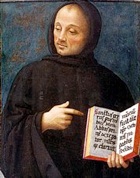


St Peter Abbot,
Panel from predella of San Pietro Polyptych (1495-1500) by Perugino
Sacristy, San Pietro
The oldest version of the legend of St Peter Abbot, which is conserved in the Biblioteca Comunale Augusta di Perugia, probably dates to the 15th century. This must have been unknown or unavailable to the Bollandists, who published versions (BHL 6765-6) from the 17th century.
According to this hagiographic tradition, Bishop Honestus gave the site of the old church of San Pietro to St Peter Abbot who came from a noble family from Agello (on Lake Trasimeno). (A later version of the legend identifies this as the Vincioli family, who were counts of Agello in the 17th century). He rebuilt the church and established a Benedictine Abbazia di San Pietro next to it.
A privilege issued by the Emperor Conrad II in 1027 to the Abbazia di San Pietro confirms that it had been founded by an abbot named Peter. It also refers to a an earlier privilege granted by the Emperor Otto II. This earlier imperial privilege was almost certainly a confirmation of one that had been granted by the papacy, which adds weight to the tradition summarised in an inscription in the first cloister of the complex: this records that St Peter Abbot established the monastery in 964 and that Pope John XIII re-consecrated its church in 969.
One of the first episodes reported in these legends is an encounter with Otto II, after his coronation in Rome (as co-emperor with his father) in 967. St Peter reproved Otto II for having allowed his men to devastate the country around Perugia. When Otto II accepted this rebuke, St Peter proceeded to exhort him to act against bishops who were guilty of misconduct and simony.
The year in which St Peter Abbot died is unknown:
-
✴Later versions of the legend say that he died in 1007 after 40 years as abbot.
-
✴However, the abbot who was involved in the dispute with Bishop Conone (see below) in 1002 was unnamed, which would be odd if this post still belonged to St Peter Abbot.
-
✴An abbot named Peter was documented in 1022, although this was almost certainly a successor of the same name.
-
✴St Peter Abbot was named as the founder of the abbey in the privilege issued by the Emperor Conrad II in 1027 (see below), by which time he was certainly dead.
Miracle of the Column


St Peter Abbot Displaced Column
The 2nd column of the left of the church of San Pietro is known as the column of the miracle, a reference to an accident that happened during reconstruction, when the column fell and nearly killed a workman. However, St Peter Abbot was able to stop it in mid air by making the sign of the Cross.
The column, which remains asymmetrically mounted on its base, has a fresco (ca. 1465) of St Peter Abbot that is attributed to Benedetto Bonfigli and a cross is carved on the capital above. (See the page on the interior of the church).
Cult of St Peter Abbot
The cult of St Peter Abbot seems to have developed only after the transfer of the abbey to the Cassinese Congregation (a reformed congregation of the Benedictine Order) in 1436. His relics were rediscovered in the church in December of that year and placed under the high altar.
The relics were moved on three occasions in the 16th century:
-
✴In 1534, they were moved to the sacristy while work was carried out in the apse.
-
✴In 1573, they were recorded as being once more under the high altar.
-
✴In 1592, they were moved to a new coffin and moved once more to the sacristy to permit the remodelling of the apse.
In 1609, Bishop Napoleone Comitoli arranged for the simultaneous translation of the relics of three saints:
-
✴those of St Herculanus from the Duomo to Sant’ Ercolano;
-
✴those of “St” Bevignate from San Bevignate to the Duomo; and
-
✴those of St Peter Abbot from the sacristy to the high altar of San Pietro.
In 1631, St Peter Abbot was formally adopted as a defender of he city of Perugia.
Read more:
S. Zucchini, “La Vita di San Pietro Abate: Un Agiografia Attraverso i Secoli”, Bollettino della Deputazione di Storia Patria per l' Umbria, 100:1 (2003) 87-183
Return to Saints of Perugia

